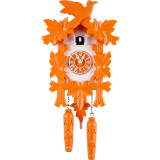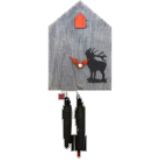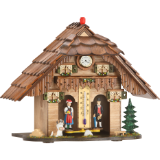
History of the German Cuckoo Clock
April 9, 2024
Blog
The German cuckoo clock history began in the Bavarian area of Germany. In the years before 1630, time was kept with a sundial and an hourglass. When a glass peddler came back from Czechoslovakia returned with a crude clock called a wood-beam clock it changed their world. It had simple wooden gears and stones used as weight with no pendulum. This was a huge improvement over the hourglass and sundial. The people inhabiting the area began to make the crude clocks in their huts. The German cuckoo clock was invented. The inhabitants would work all winter and then a peddler would take them to various other parts of the world and sell them in the spring. The Black Forest Clock became popular around the world.
The Black Forest clock was a great improvement over the crude one that had been brought back by the peddler. The Black Forest clock was still not a cuckoo clock, they were called artist clocks. Friedrich Dilger from a small village in Germany went to France to study advance clock making and the tool skills. When his studies were completed he brought the new technology to the Germany where the genuine Black Forest clock was made.
The very first German cuckoo clock was made in the village of Schonwald by an inventive German clockmaker by the name of Franz Anton Ketterer. The clocks before him featured elaborate moving features including dancers, a skeleton which turned over an hourglass each hour and even a cow being struck by a butcher’s ax. Ketterer’s clock was the first authentic German cuckoo clock made. He added the rooster and the sound to make it say coo-coo. It was ingenious the way he developed the mechanism to run the clock. The sound was made by twin bellows that sent air through small pipes. That is the same mechanism that is used today in a German cuckoo clock.
The Black Forest clock was intricate in design. Some villages or areas would specialize by some making the gears; someone else might make the casing and the intricate woodcarvings done by trained woodcarvers. These genuine cuckoo clocks were then assembled and sold. As the years went on they began to take on themes such as the hunter theme. They were elaborately adorned with hunting images, antlers, deer heads and powder horns. These were recognized as the German cuckoo clock.
Another style was the Bahnhausle style of clocks that were adorned by wild grape vines. They were carved to look like the lookout buildings the Italian tunnel builders built while building the railroad. What we now know as the Black Forest Clock originated from this design.
Today, you can find an authentic cuckoo clock in fine stores, on the Internet, or you could travel to Germany. Genuine cuckoo clocks are made by other companies such as Hekas and Romba clocks. Another famous clockmaker is Anton Schneider. He makes over 300 styles of genuine cuckoo clocks.
The German cuckoo clock of today is made using the same weight driven mechanism as a German cuckoo clock, but there are also clocks made with small quartz batteries. The cuckoo is achieved by a digitized recording. Whatever Black Forest clock or Black Forest clock you choose, you can appreciate it a little more by knowing the history.
The Black Forest clock was a great improvement over the crude one that had been brought back by the peddler. The Black Forest clock was still not a cuckoo clock, they were called artist clocks. Friedrich Dilger from a small village in Germany went to France to study advance clock making and the tool skills. When his studies were completed he brought the new technology to the Germany where the genuine Black Forest clock was made.
The very first German cuckoo clock was made in the village of Schonwald by an inventive German clockmaker by the name of Franz Anton Ketterer. The clocks before him featured elaborate moving features including dancers, a skeleton which turned over an hourglass each hour and even a cow being struck by a butcher’s ax. Ketterer’s clock was the first authentic German cuckoo clock made. He added the rooster and the sound to make it say coo-coo. It was ingenious the way he developed the mechanism to run the clock. The sound was made by twin bellows that sent air through small pipes. That is the same mechanism that is used today in a German cuckoo clock.
The Black Forest clock was intricate in design. Some villages or areas would specialize by some making the gears; someone else might make the casing and the intricate woodcarvings done by trained woodcarvers. These genuine cuckoo clocks were then assembled and sold. As the years went on they began to take on themes such as the hunter theme. They were elaborately adorned with hunting images, antlers, deer heads and powder horns. These were recognized as the German cuckoo clock.
Another style was the Bahnhausle style of clocks that were adorned by wild grape vines. They were carved to look like the lookout buildings the Italian tunnel builders built while building the railroad. What we now know as the Black Forest Clock originated from this design.
Today, you can find an authentic cuckoo clock in fine stores, on the Internet, or you could travel to Germany. Genuine cuckoo clocks are made by other companies such as Hekas and Romba clocks. Another famous clockmaker is Anton Schneider. He makes over 300 styles of genuine cuckoo clocks.
The German cuckoo clock of today is made using the same weight driven mechanism as a German cuckoo clock, but there are also clocks made with small quartz batteries. The cuckoo is achieved by a digitized recording. Whatever Black Forest clock or Black Forest clock you choose, you can appreciate it a little more by knowing the history.




























